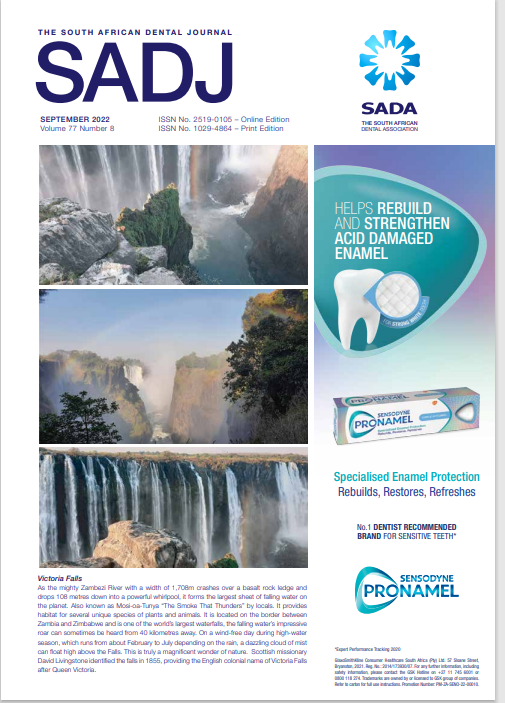Immediately loaded zygomatic implants used for a functional and aesthetic rehabilitation following a combined maxillectomy and rhinectomy
DOI:
https://doi.org/10.17159/2519-0105/2022/v77no8a6Keywords:
malignant, carcinoma and melanomaAbstract
Malignancies of the nasal vestibule are rare, yet may result in massive destruction of the face if left untreated. The position and extent of the resulting defects is not only a rehabilitative challenge but also a major psychological burden for the patient. This paper
describes a technique for designing and fabricating an immediate surgical obturator and nasal prosthesis to help minimize the post-surgical impact following a total rhinectomy and partial maxillectomy procedure in a patient diagnosed with a squamous cell carcinoma of the nasal septum. The restoration consisted of bilateral zygomatic implants attached to a resin framework
housing a central magnet. The latter was used to retain the nasal prosthesis and help support an interim maxillary obturator. Conventional impressions of the dentition and a moulage of the nasal defect were taken. The master casts were poured and
used for design and fabrication of the obturator and nasal wax pattern Colour matching of the nose and facial areas was performed with the aid of a digital spectrophotometer (Quickweigh; Spectromatch Ltd., UK), and a silicone nasal prosthesis was fabricated. This case demonstrated how both a functional rehabilitation and reduced psychological impact was achieved by delivering an immediate surgical obturator and facial prosthesis.
Downloads
References
Rodrigues S, Shenoy VK, Shenoy K. Prosthetic rehabilitation of a patient after partial rhinectomy: A clinical report. J Prosthet Dent 2005;93:125-8
Patel P, Tiwari R, Karim AB, et al. Squamous cell carcinoma of the nasal vestibule. J Laryngol Otol 1992; 106:332.
Mendenhall WM, Stringer SP, Cassisi NJ Mendenhall NP. Squamous cell carcinoma of the nasal vestibule. Head & Neck 1999;385-393
Hitotsumatsu T et al. Surgical anatomy of the midface and the midline skull base; Operative Techniques in Neurosurgery 1999;2(4):160-180
Fernandez et al. Immediate Implant Placement and Provisionalization Following Tumour ResectiveSurgery in the Midfacial Region: A Case
Series; J Prosthod 2018; 27: 476–481
Trevisiol L, Procacci P, D’Agostino A, et al: Rehabilitation of a complex midfacial defect by means of a zygoma-implant-supported prosthesis
and nasal epithesis: a novel technique. Int J Implant Dent 2016;2:7
Mothopi M et al. The need for versatility in the prosthodontic treatment of maxillofacial defects;SADJ 2012;67 (7): 420 - 423
Cawood JI, Stoelinga PJ. International Academy for Oral and Facial Rehabilitation – Consensusn Report. nt J Oral Maxillofac Surg 2006: 35: 195–198
Nagaraj E. Definitive magnetic nasal prosthesis for partial nasal defect. Indian J Dent Res 2011; 22 (4): 597-599
Phasuk K et al. Maxillofacial Prosthetics; Oral Maxillofac Surg Clin N Am 2018; 30:487–497
Burget GC, Menick FJ. Nasal support and lining: The marriage of beauty and blood supply. Plast Reconstr Surg 1989;84:189-202.
Javid N. The use of magnets in a maxillofacial prosthesis. J Prosthet Dent 1971;25:334-40.
Downloads
Published
Issue
Section
License

This work is licensed under a Creative Commons Attribution-NonCommercial 4.0 International License.






.png)